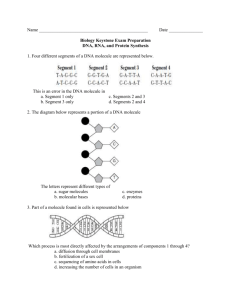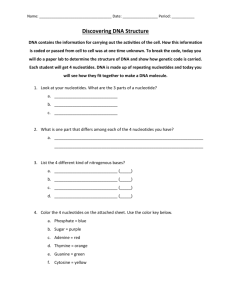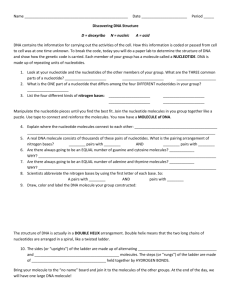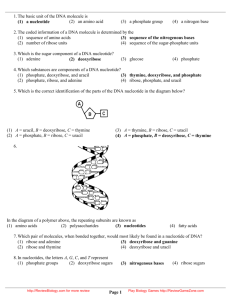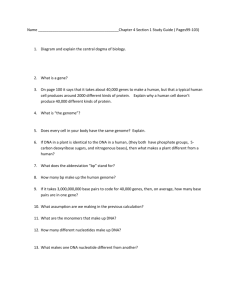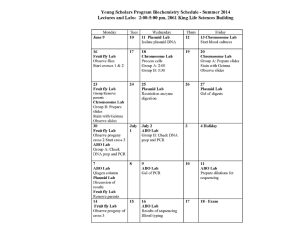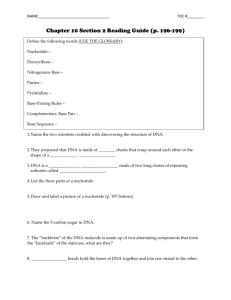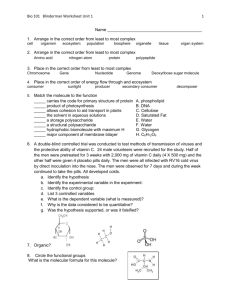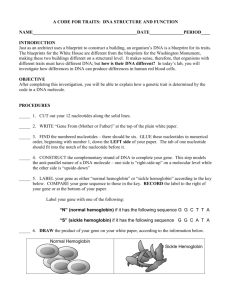DNA Structure Two types of nucleic acids exist: deoxyribonucleic
advertisement
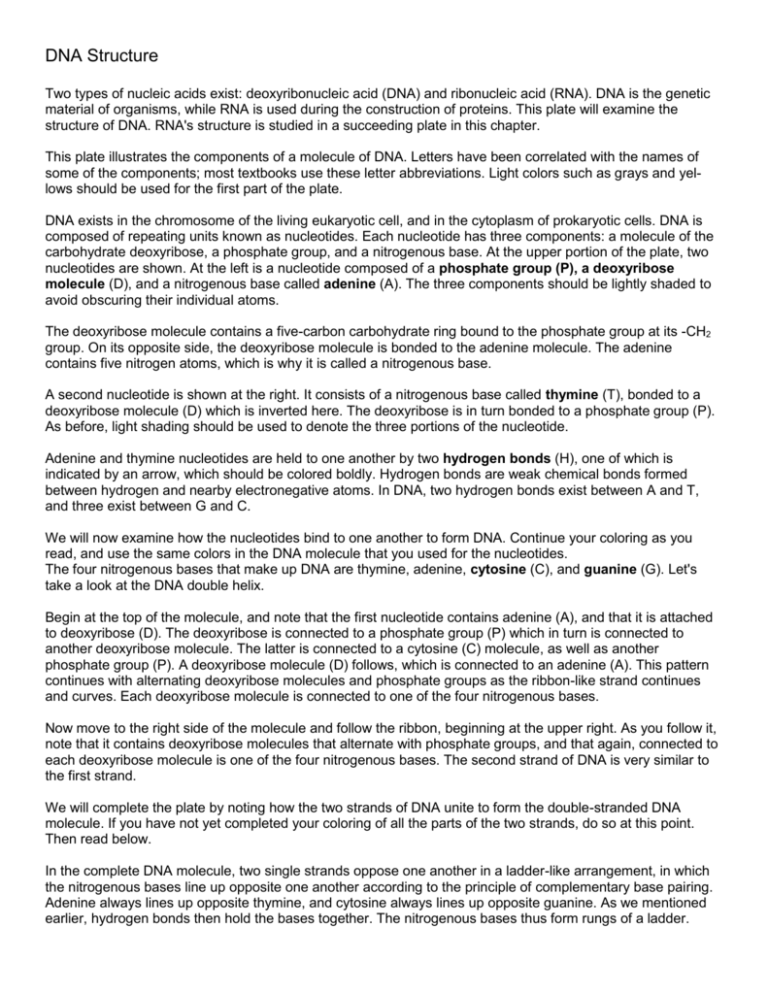
DNA Structure Two types of nucleic acids exist: deoxyribonucleic acid (DNA) and ribonucleic acid (RNA). DNA is the genetic material of organisms, while RNA is used during the construction of proteins. This plate will examine the structure of DNA. RNA's structure is studied in a succeeding plate in this chapter. This plate illustrates the components of a molecule of DNA. Letters have been correlated with the names of some of the components; most textbooks use these letter abbreviations. Light colors such as grays and yellows should be used for the first part of the plate. DNA exists in the chromosome of the living eukaryotic cell, and in the cytoplasm of prokaryotic cells. DNA is composed of repeating units known as nucleotides. Each nucleotide has three components: a molecule of the carbohydrate deoxyribose, a phosphate group, and a nitrogenous base. At the upper portion of the plate, two nucleotides are shown. At the left is a nucleotide composed of a phosphate group (P), a deoxyribose molecule (D), and a nitrogenous base called adenine (A). The three components should be lightly shaded to avoid obscuring their individual atoms. The deoxyribose molecule contains a five-carbon carbohydrate ring bound to the phosphate group at its -CH2 group. On its opposite side, the deoxyribose molecule is bonded to the adenine molecule. The adenine contains five nitrogen atoms, which is why it is called a nitrogenous base. A second nucleotide is shown at the right. It consists of a nitrogenous base called thymine (T), bonded to a deoxyribose molecule (D) which is inverted here. The deoxyribose is in turn bonded to a phosphate group (P). As before, light shading should be used to denote the three portions of the nucleotide. Adenine and thymine nucleotides are held to one another by two hydrogen bonds (H), one of which is indicated by an arrow, which should be colored boldly. Hydrogen bonds are weak chemical bonds formed between hydrogen and nearby electronegative atoms. In DNA, two hydrogen bonds exist between A and T, and three exist between G and C. We will now examine how the nucleotides bind to one another to form DNA. Continue your coloring as you read, and use the same colors in the DNA molecule that you used for the nucleotides. The four nitrogenous bases that make up DNA are thymine, adenine, cytosine (C), and guanine (G). Let's take a look at the DNA double helix. Begin at the top of the molecule, and note that the first nucleotide contains adenine (A), and that it is attached to deoxyribose (D). The deoxyribose is connected to a phosphate group (P) which in turn is connected to another deoxyribose molecule. The latter is connected to a cytosine (C) molecule, as well as another phosphate group (P). A deoxyribose molecule (D) follows, which is connected to an adenine (A). This pattern continues with alternating deoxyribose molecules and phosphate groups as the ribbon-like strand continues and curves. Each deoxyribose molecule is connected to one of the four nitrogenous bases. Now move to the right side of the molecule and follow the ribbon, beginning at the upper right. As you follow it, note that it contains deoxyribose molecules that alternate with phosphate groups, and that again, connected to each deoxyribose molecule is one of the four nitrogenous bases. The second strand of DNA is very similar to the first strand. We will complete the plate by noting how the two strands of DNA unite to form the double-stranded DNA molecule. If you have not yet completed your coloring of all the parts of the two strands, do so at this point. Then read below. In the complete DNA molecule, two single strands oppose one another in a ladder-like arrangement, in which the nitrogenous bases line up opposite one another according to the principle of complementary base pairing. Adenine always lines up opposite thymine, and cytosine always lines up opposite guanine. As we mentioned earlier, hydrogen bonds then hold the bases together. The nitrogenous bases thus form rungs of a ladder.
